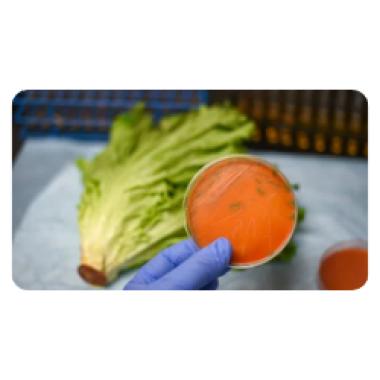Avoiding listeria infection: where and how?
Günter Dorn - Veröffentlicht am 20 April 2023
Fever, muscle pain, as well as vomiting and diarrhoea can be the consequences of a listeria infection. What listeria are, what environment they need and what effects a listeria infection can have, you will learn in this blog post. In addition, I would like to tell you about various incidents that I have experienced in my everyday working life.
What does the term listeria mean?
There are different species of Listeria, which are distributed worldwide. These are bacteria in the form of gram-positive, motile, non-spore-forming, catalase-positive and facultative anaerobic rods. In principle, Listeria have only low nutrient requirements. In the following, we refer to the Listeria species Listeria monocytogenes. These bacteria multiply in the temperature range from -0.4 °C to +45 °C under otherwise optimal growth conditions. Listeria monocytogenes can multiply optimally in a pH range of 4.4 to 9.4. They can occur anywhere in the environment (e.g. in soil, on plants, in waste water and in agricultural areas). In the food sector, they often occur during milking, slaughter, contaminated vegetables and contamination via the environment.
How does a Listeria infection happen?
"Listeria infection is also called listeriosis and is a food-borne infectious disease. In addition to a variety of animal foods such as poultry, meat, meat products (e.g. sausage), fish, fish products (mainly smoked fish), milk and dairy products (especially cheese), listeria is not infrequently found on plant foods, e.g. pre-cut salads." This is the definition of listeriosis from the Robert Koch Institute.
What are the possible consequences of a Listeria infection?
Listeriosis can manifest itself in the form of fever, muscle pain, vomiting and diarrhoea. Healthy people normally react with a severe febrile reaction, which can be cured. However, there is a great danger for immunocompromised persons, such as newborns, old people, patients with chronic diseases, transplanted persons and pregnant women. In pregnant women, transmission to the child is possible. This shows how important it is to avoid and eliminate listeria and to prevent listeriosis.

Practical example: Listeria infection
In practice, I often come across incidents in the meat grinder, gully and evaporator areas with positive listeriosis reports. Sometimes there are also bacteria on floors with damage to joints or detached, damaged coverings. The increase in freshly prepared food, leads to the challenge and a thoughtful approach to receiving fresh produce, storage and processing. Let's take a simple example of a delivered box of fresh vegetables and fresh salads. This crate is placed on the floor in the goods receiving area. From there, the crate is stored in the cold store and later brought to the chopping kitchen. The crate is then emptied in the sink, the contents washed and processed. The contact surface of the crate/crate bottom is the potential source of listeria formation here.
Here is another example: The mincer, which is disassembled and cleaned after use, has a heavy perforated disc. This has to be cleaned, among other things. In practice, this is often done by placing it on the floor and rinsing it out with a working hose. Unfortunately, this is still done and is a highly risky practice. Because the general rule is: "Nothing from the floor (e.g. gully cover) to the table and nothing from the table (e.g. perforated disc) to the floor." These are simple rules to avoid cross-contamination. If the cause of the listeria originates on the floor and damage has been detected, it is advisable to act quickly and repair the damage caused.

For the reasons mentioned above, cleaning and disinfection of drains and gutters should take place regularly. It is advisable to use a suitable agent with a persistent foaming effect. Gullies can be reached in this way and the contact time is extended. Since drains should have a prescribed slope for structural reasons, a liquid application is not nearly effective or sufficient. The formation of listeria is usually associated with biofilms in the drain, this is composed of a wide range of microbes. These communicate with each other and benefit from working together. The removal of listeria should only be carried out by professionally instructed persons. In this way, the spread of listeria can be prevented and the problem can be combated in a targeted manner.

The germs are often found in vaporisers. Here, too, regular inspection and cleaning is a must. The drains of the drip tray must be neat. Slope and diameter must meet the requirements. Common problems are backflows/logs in the drain pipe caused by freezing of the residues. If there is an increase in water accumulation during defrosting (e.g. shutdown during cleaning in the surrounding area), it runs over the edge of the drip trays and thus spreads the contamination.
A fine analysis of the listeria gives an indication of germs that have settled in the operation or, in the case of different results, an indication of recurring contamination.
I am happy to support you in preventing the development of listeria and in preventing listeriosis. I am also happy to be your personal contact for optimising your existing measures. Contact me to identify your potentials!
Source list:
https://www.rki.de/DE/Content/Infekt/EpidBull/Merkblaetter/Ratgeber_Listeriose.html
Weitere Use-Cases

„Ich bin da, wo auch immer Sie mich benötigen.“

Ich stehe Ihnen mit umfassenden branchenspezifischen Kenntnissen im Bereich der Reinigungsprozesse zur Seite.
-
Conscious sustainability in professional use02 June 2023
-
Avoiding listeria infection: where and how?20 April 2023
-
Cross-contamination: This is how it can be prevented in the online trade of unpackaged goods!13 March 2023
-
Cold chain "Quality from the beginning to consumption".30 January 2023
-
Food defense in indoor bakery16 January 2023
-
Mandatory reuse 202305 January 2023
© JD5 - Günter Dorn
Crafted with ❤ by Werwolf Media.
 English (United Kingdom)
English (United Kingdom)  Deutsch (Deutschland)
Deutsch (Deutschland) 